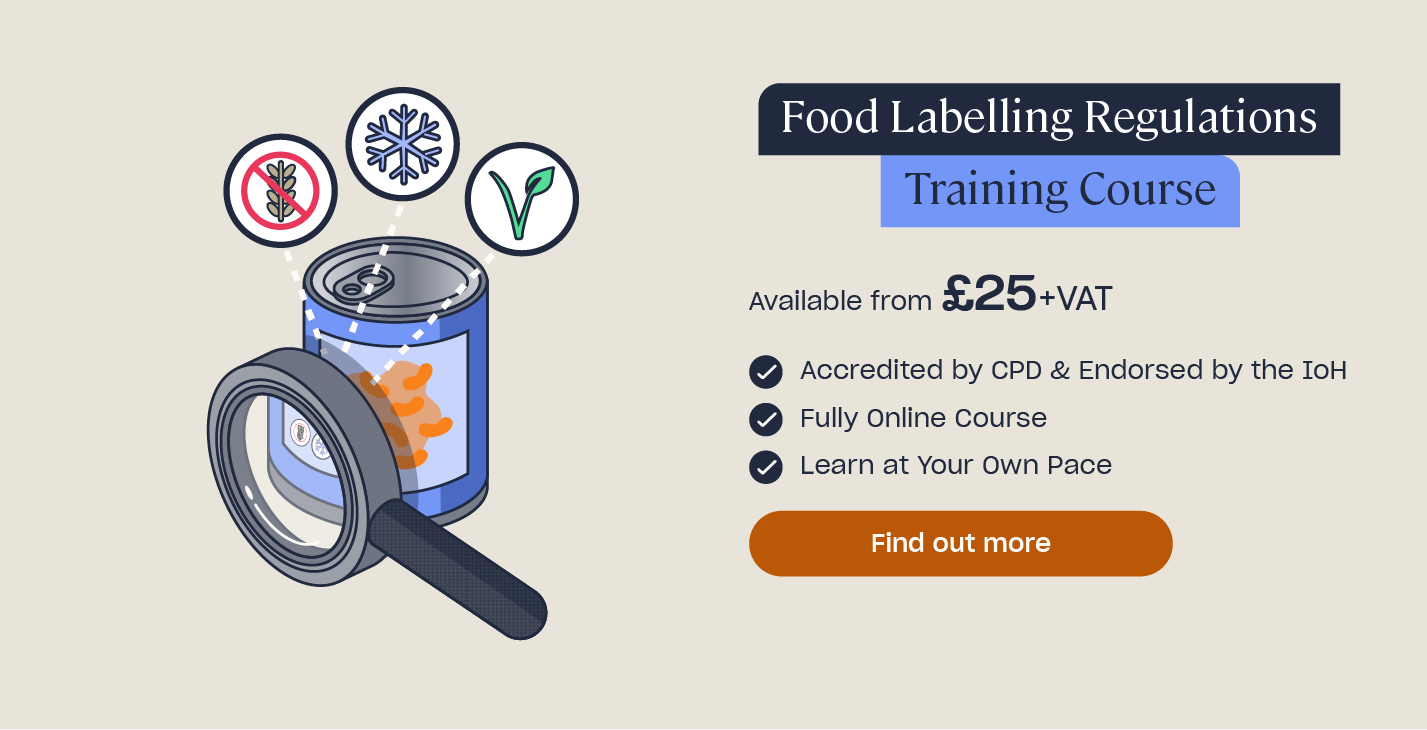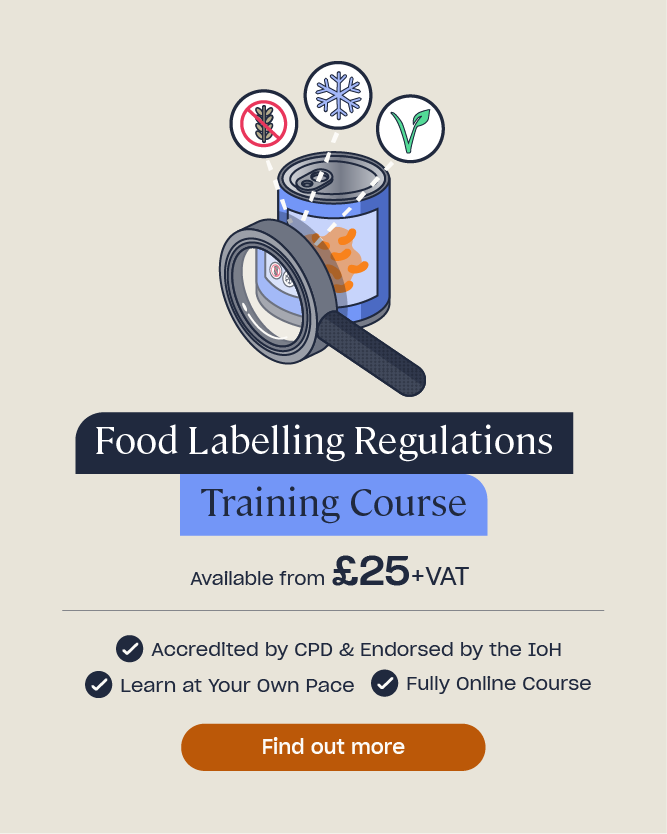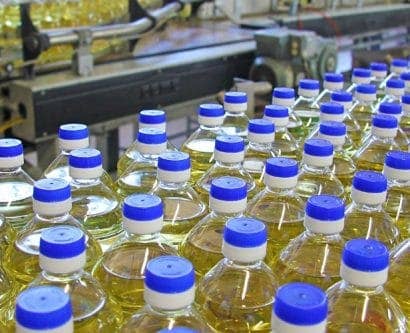A Guide to Food Labelling Regulations
This guide to food labelling regulations includes information on the allergen, nutrition, and organic labelling requirements in the UK. It also explains Natasha’s Law, a new food labelling legislation created after Natasha Ednan-Laperouse had a fatal allergic reaction.
Allergen Labelling
When a pre-packaged food item contains any of the 14 named allergens the allergenic ingredients must be emphasised on the food packaging label, such as in bold. It must be located in a single place to make it easy to identify.
Currently, all foods produced and packed on the premises, such as those sold in delis and cafés, do not require labelling on packaging, provided that customers are informed that they can ask about allergens. However, Natasha’s Law, requires businesses to label the food with a full list of ingredients for all food they make on the premises, such as sandwiches.
What is Natasha’s Law?
Natasha’s Law is a new food labelling legislation that came into force in October 2021, with similar arrangements expected to follow in other nations for a UK-wide approach. It was created following the death of 15 year old Natasha Ednan-Laperouse, who had a fatal allergic reaction to a Pret a Manager baguette that contained sesame seeds. It requires businesses to label food that is pre-packed directly for sale and made on the premises with a full list of ingredients, including allergens.
The Food Standards Agency (FSA) has developed guidance on the list of foods to which Natasha’s Law applies. Food businesses were given a two-year transition period to prepare for these new requirements.
For further guidance you can visit the FSA’s information page.
When Should I Use Precautionary Allergen Labelling?
Food allergen labelling prevents people with food allergies and intolerances for consuming foods which may cause stomach upset or anaphylaxis (a severe allergic reaction).
So, if you produce and package biscuits in a delicatessen you could create stickers to put on the back so that your customers can see the ingredients you have used and check for allergenic contents.

What are the Named Allergens?
There are 14 named allergens. If your product contains any of these or was prepared in a place where these are also prepared, you must say so on the product packaging. The named allergens are:
1. Celery and celeriac
2. Cereals containing gluten
3. Crustaceans
4. Eggs
5. Fish
6. Lupin
7. Molluscs
8. Milk
9. Mustard
10. Nuts
11. Peanuts
12. Sesame seeds
13. Soybeans
14. Sulphur dioxide and sulphites at levels above 10mg per kg or 10ml per litre
Need a Course?
Our Food Labelling Regulations Training Course has been designed by food industry experts to help food businesses understand how to label their food products legally and correctly.
Nutrition Labelling 2016
In 2016 it became mandatory for companies to display nutritional information on the back of prepacked food. Of course, these nutrition requirements do not apply to natural mineral waters or food supplements. Both of which are governed by separate directives.
PARNUT foods are manufactured to meet particular nutritional requirements such as medical food products, baby food and formula, and meal and total diet replacement foods, and these have specific nutritional rules. For more information on packaging requires for PARNUT foods check out the FSA guide to PARNUT labelling.
All pre-packaged foods should feature nutrition information on the back of the packaging. This can also be repeated voluntarily on the front of the pack. The aim of this is to allow consumers to make healthier choices and to understand what they are consuming. This article will look at nutrition guidance for both the front and back of prepacked foods.
Mandatory Nutrition Labels: Back of the Pack
On the back of your prepacked food, you must provide information on:
- Energy value (in kJ and kcal).
- Fat levels.
- Saturated fat levels.
- Carbohydrate levels.
- Salt content.
- Protein.
- Sugars content.
Nutritional information has to be presented in a specific order: energy, fat, saturates, carbohydrate, sugars, protein and salt.

Front of Pack and Additional Information
Front of pack information is intended to give your consumers an overview of nutritional information. These regulations have been created to help producers improve public health. Repeating information from the back of the pack on the front of the pack is voluntary.
Other nutritional labelling requirements include:
- High caffeine content: Drinks with a high caffeine content should be labelled as ‘not recommended for children, pregnant and breastfeeding women’. The caffeine content must be quoted.
- Minimum font size: Labels must be clear and all mandatory information should be included in a minimum font size.
- Origin information: Fresh and frozen meat must feature origin information, such as ‘Scotland’, ‘England’ or ‘Wales’. If the origin of the main ingredients is different to where the final product is made, this must also be declared.
- Vegetable oil: The types of vegetable oil used in the food must be stated.
- Date of first freezing: alongside use-by and best-before dates on pre-packaged meat and fish, they must also display a date of first freezing.
- Added water: if meat and fish products contain more than 5% added water and look like a cut, joint or slice, then the fact that they include added water must be shown in the name of the food.
Organic Food Labelling
To label a food product as organic or use phrasing such as ‘organically grown’ the product and farming methods have to meet a series of strict guidelines.
You cannot label a product as organic if it has more than 5% non-organic ingredients.
Organic food labels must include:
- Certification code.
- Certification symbol (this will depend on which association accredits your organic produce).
- EU organic logo.
- The origin of raw materials.
- Traceability code.












